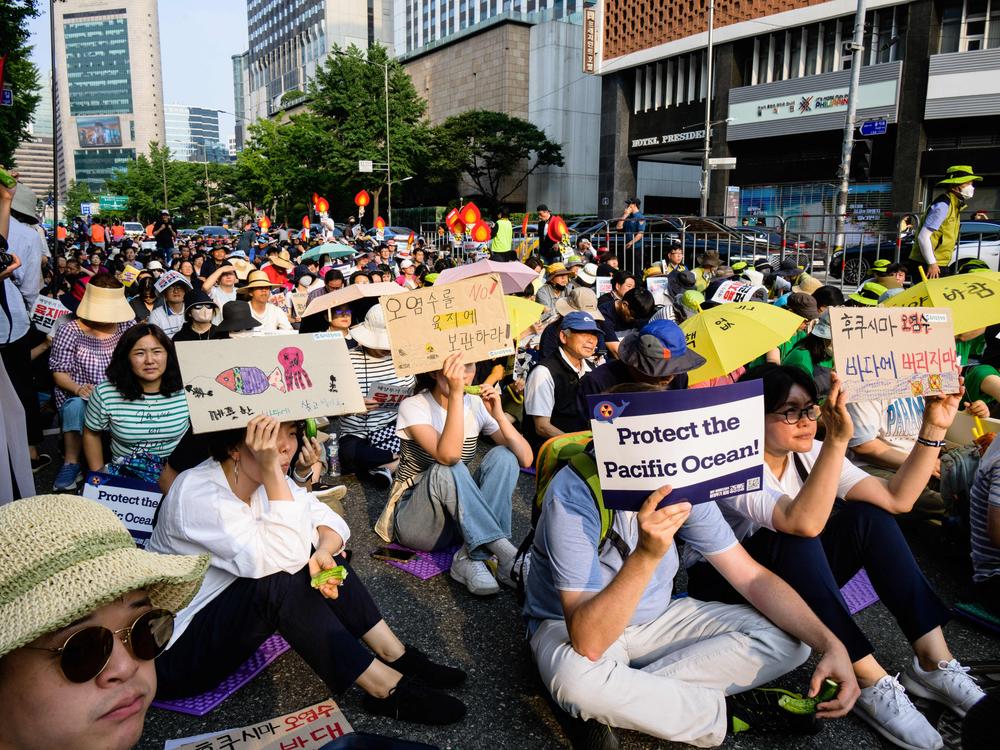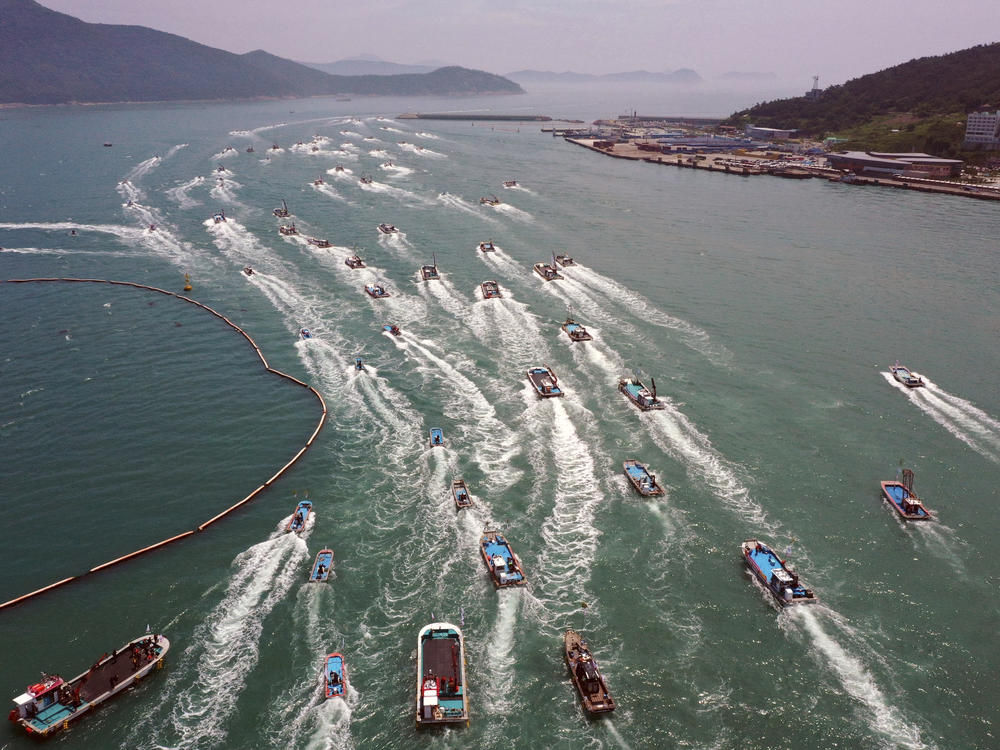Section Branding
Header Content
As Japan prepares to release Fukushima wastewater, anxiety grows across South Korea
Primary Content
SEOUL, South Korea — For 30 years, Choi Jeong-hee has been selling olive flounder, rockfish and live octopus at the bustling Gwangjang traditional market in the heart of Seoul. But come July, he fears he may have to switch to another business.
As Japan plans to release treated radioactive water from the crippled Fukushima nuclear power plant into the sea this summer, South Koreans concerned about its effect on the marine environment and seafood are buying less fish and stocking up on sea salt.
"Compared to last year, sales have more than halved," Choi says.
The impending water discharge can threaten the fragile rapprochement between the two neighboring countries that began earlier this year, following a long period of tension over historical disputes.
After the nuclear meltdown triggered by a magnitude 9.0 earthquake and tsunami in 2011, Japan has stored the cooling water for nuclear fuel and rain and groundwater seeping through the damaged reactor building in large tanks. In 2021, the country decided to release the water, expecting its storage capacity to run out soon.
Its plan is to purify the water using a filtering system called Advanced Liquid Processing System, or ALPS, and dilute it with more than 100 times' quantity of sea water.
Director General Rafael Mariano Grossi of the International Atomic Energy Agency (IAEA) said after the plan's announcement, "The method Japan has chosen is both technically feasible and in line with international practice."
An IAEA task force, which includes experts from 11 countries, is conducting a review of the discharge plan and process.
Japan recently completed construction of an underwater tunnel, through which the treated and diluted water will flow into the ocean for the next 30 years. A two-week-long test run of the tunnel is expected to end this week.
According to a recent joint survey by South Korea's Hankook Ilbo and Japan's Yomiuri Shimbun newspapers, 84% of South Koreans disapproved of the release.
As some Koreans rushed to buy salt before the release, out of concerns about potential health risks, the number of retail orders at the National Federation of Fisheries Cooperatives branch in Sinan county, which produces 80% of the nation's sea salt, jumped a hundredfold in recent days compared to a year ago.
As of June 23, the average retail price for sea salt rose to 14,562 Korean won (slightly more than $11) for 5 kilograms, from 11,224 won (about $8.60) last year, according to data compiled by the Korea Agro-Fisheries and Food Trade Corporation.
The South Korean government claims there's no sign of widespread stockpiling and attributes the price spike to the declining volume of salt production due to heavy rains this spring.
The Sinan Fisheries Cooperative says the sudden growth in demand created a bottleneck in distribution and raised logistical costs.
"I bought them in bulk last year," says Yang Soo-kyung, a housekeeper in Seoul, when asked if she plans to buy any salt. "I bought them in advance because I was worried about this year's Kimjang," she adds, referring to the annual kimchi-making practice, in which salt is used to cure vegetables.
Yang says people are more cautious about eating fish. "I think people don't buy fish as much as before these days, especially fish from deep waters."
Some Koreans, however, say the fears are overblown and may soon fade away.
Lee Yoon-jae works at his father's dry goods store at the Gwangjang market. He says the news of the upcoming Fukushima water release has not significantly impacted the price of dried seaweed and salt at the store.
He says he understands the fear some customers have about food safety but suspects there are other reasons.
"Water is one of the most basic resources, and if you think it's contaminated, you can't help but feel scared," Lee says. "But if it's scientifically proven [to be safe], I hope people trust that."
The South Korean government has been checking radiation levels of seafood and sea water since the 2011 disaster and recently started holding daily briefings to reassure the nation of its commitment to safety. It vowed to oppose the water release if the procedure fails to meet regulatory standards.
Lee says he thinks political polarization is blocking some Koreans from trusting the government.
"In South Korea, you're either on our side or on their side. I think half of the people trust the government, and the other half don't," he says. "I personally think the agitation is driven by people's political stance."
Improved ties, but mistrust remains
South Korea and Japan — key U.S. allies in Asia — have recently taken steps to remedy their relationship, which deteriorated in the past few years over the issue of forced labor during Japan's 1910-45 colonization.
In 2018, South Korea's Supreme Court ordered two Japanese companies to pay compensation to Korean victims of forced labor. Japan imposed trade restrictions in response to the ruling, and South Koreans started a boycott of Japanese products.
South Korean President Yoon Suk Yeol pledged to improve bilateral relations when he came into office in May 2022. In March, his administration announced a plan to have a South Korean foundation pay the victims in place of the Japanese companies.
Surviving victims and civil activists opposed the plan, but it led to resumption of summits between Yoon and his Japanese counterpart, Prime Minister Fumio Kishida, and promises for closer cooperation in security and economy.
The United States, which seeks stronger partnerships with its allies in containing China, welcomed the move. At a trilateral meeting in May, President Biden "commended Prime Minister Kishida and President Yoon on their courageous work to improve their bilateral ties, noting that our trilateral partnership and the Indo-Pacific are stronger because of their efforts," according to a White House readout.
The reconciliatory mood improved South Korean and Japanese people's perceptions of each other. In the Hankook-Yomiuri poll, 43.5% of Koreans — the highest since 1995 — and 45% of Japanese said the current bilateral relationship is good, dramatically up from last year's 17.6% and 17%, respectively.
But both countries were not as optimistic about the future. Asked if they expect the relationship to improve further, 37.7% of Koreans — down from last year's 52.9% — and 34% of Japanese agreed.
And the level of trust toward each other is not as high as their assessment of the current state. 27.6% of South Koreans said they can trust Japan, while 40% of Japanese respondents said they can trust South Korea.
Choi Eunmi, a Japan specialist at the Seoul-based think tank Asan Institute, says the public opinion surveys show that the basis for the ongoing rapprochement is not firm.
She notes the Fukushima issue is especially difficult to handle, as it stands out from other issues that have troubled the two countries' relationship.
"Because the Fukushima issue is directly related to people's safety and health, even those who do not hate Japan or those who are understanding of Japan's position on historical issues still express concerns about the Fukushima issue," she says.
At the root of the fear are mistrust and anxiety about invisible, long-term impacts, Choi analyzes. "People are mistrustful not because it's Japan, but because it's a region where the accident happened," she says, adding South Koreans would have been just as anxious with a different neighboring country.
In order to soothe the anxiety, Choi says what happens after the water discharge starts is important. South Korea should seek a promise from the Japanese government for continued involvement in inspection and monitoring and for hazard control measures.
"The water release is not once and done. It will continue for 30 years," she says.
NPR international correspondent Anthony Kuhn contributed to this story in Seoul.
Copyright 2023 NPR. To see more, visit https://www.npr.org.


